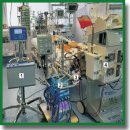
Nitrogen Oxide-Added Extracorporeal Membrane Oxygenation for Treating Critical Acute Heart Failure after Cardiac Surgery
The aim of the study was to test the use of gaseous nitric oxide added to the extracorporeal membrane oxygenation (ECMO) system for treating critical acute heart failure after cardiac surgery.
Materials and Methods. Venoarterial ECMO with addition of nitric oxide into the extracorporeal circuit was used for treating a 52-year-old patient after two-step cardiac surgery for acute dissection of the thoracic aorta and aortic valve insufficiency. After the Bentall–de Bono procedure, a technical error was revealed: that was a non-functioning anastomosis to the right coronary artery, which caused massive ischemic myocardial injury. An emergency myocardial revascularization was performed with the help of the cardiopulmonary bypass converted into ECMO; the patient’s condition improved and he was transferred to the ICU.
Results. Considering the sharp decrease in heart contractility and the extremely high level of myocardial damage markers, it was decided to supply nitric oxide (40 ppm) to the ECMO circuit. A positive effect was noted within 8 h from the start of the procedure: the concentration of creatine phosphokinase-MB decreased almost 4 times and the concentration of troponin I decreased twofold. The most pronounced changes were observed by the end of day 1: a significant decrease in the concentration of myocardial damage markers, a decrease in the VIS indicator by 7.5 times; an improvement in the contractile function. Further on, the patient’s condition gradually stabilized: the manifestations of acute heart failure and multiple organ failure stopped, and then ECMO was discontinued after 82 h of work. The patient was decannulated and he continued to show stable hemodynamic parameters. He was discharged from the clinic on day 18 after surgery.
Conclusion. For the first time, venoarterial ECMO with supply of gaseous nitric oxide into the extracorporeal circuit was used to support blood circulation after cardiac surgery. This made it possible to ensure the survival of the patient with critical ischemia-reperfusion injury developed after the surgery.
- Bautin A.E., Mikhaylov A.P., Laletin D.A., Rubinchik V.Ye. Right ventricle contractility during early postoperative period after coronary artery bypass grafting with cardiopulmonary bypass. Patologiya krovoobrashcheniya i kardiokhirurgiya 2014; 18(3): 34–38, https://doi.org/10.21688/1681-3472-2014-3-34-38.
- Bockeria L.A., Shatalov K.V., Makhalin M.V. The use of extracorporeal membrane oxygenation in adult cardiac surgery in a clinic in the development of cardiac or respiratory failure in the early postoperative period. Kliniceskaa i eksperimentalʹnaa hirurgia. Zurnal imeni akademika B.V. Petrovskogo 2017; 1: 45–53, https://doi.org/10.24411/2308-1198-2017-00020.
- Pichugin V.V., Seyfetdinov I.R., Medvedev A.P., Domnin S.E. Inhaled nitric oxide in the prevention of ischemic and reperfusion injuries of the heart during operations with cardiopulmonary bypass. Medicinskij alʹmanah 2019; 1: 81–87, https://doi.org/10.21145/2499-9954-2019-1-81-87.
- Karelin V.I., Buranov S.N., Pimenov O.A., Selemir V.D., Shirshin A.S. Plasma-chemical facility for NO-therapy. Medial’ 2013; 4(9): 46.
- Buranov S.N., Buyanov A.B., Voevodin S.V., Karelin V.I., Selemir V.D., Shirshin A.S. Apparatus for inhalation NO-therapy. Bioradikaly i antioksidanty 2016; 3(3): 225–226.
- Skrzypchak A.M., Lafayette N.G., Bartlett R.H., Zhou Z., Frost M.C., Meyerhoff M.E., Reynolds M.M., Annich G.M. Effect of varying nitric oxide release to prevent platelet consumption and preserve platelet function in an in vivo model of extracorporeal circulation. Perfusion 2007; 22(3): 193–200, https://doi.org/10.1177/0267659107080877.
- Kida K., Shirozu K., Yu B., Mandeville J.B., Bloch K.D., Ichinose F. Beneficial effects of nitric oxide on outcomes after cardiac arrest and cardiopulmonary resuscitation in hypothermia treated mice. Anaesthesiology 2014; 120(4): 880–889, https://doi.org/10.1097/aln.0000000000000149.
- Heusch G. Molecular basis of cardioprotection: signal transduction in ischemic pre-, post-, and remote conditioning. Circ Res 2015; 116(4): 674–699, https://doi.org/10.1161/circresaha.116.305348.
- James C., Millar J., Horton S., Brizard C., Molesworth C., Butt W. Nitric oxide administration during paediatric cardiopulmonary bypass: a randomised controlled trial. Intensive Care Med 2016; 42(11): 1744–1752, https://doi.org/10.1007/s00134-016-4420-6.
- Checchia P.A., Bronicki R.A., Muenzer J.T., Dixon D., Raithel S., Gandhi S.K., Huddleston C.B. Nitric oxide delivery during cardiopulmonary bypass reduces postoperative morbidity in children — a randomized trial. J Thorac Cardiovasc Surg 2013; 146(3): 530–536, https://doi.org/10.1016/j.jtcvs.2012.09.100.
- Chiletti R., Horton S., Bednarz A., Bartlett R., Butt W. Safety of nitric oxide added to the ECMO circuit: a pilot study in children. Perfusion 2018; 33(1): 74–76, https://doi.org/10.1177/0267659117720495.










